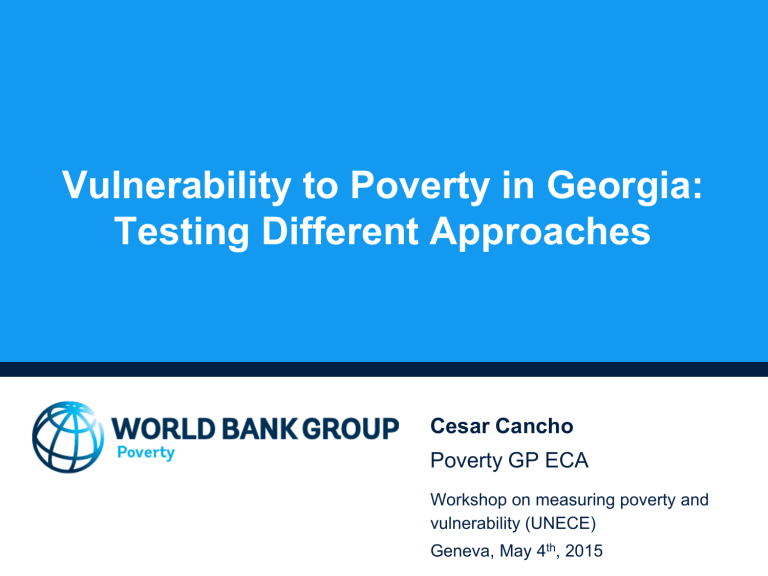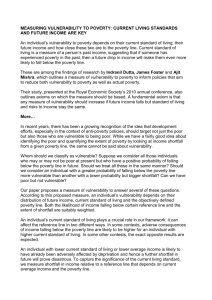Vulnerability to Poverty in Georgia: Testing Different Approaches

Vulnerability to Poverty in Georgia:
Testing Different Approaches
Cesar Cancho
Poverty GP ECA
Workshop on measuring poverty and vulnerability (UNECE)
Geneva, May 4 th , 2015
1
Summary
• Vulnerability defined a at risk of falling into poverty at t+1
• Estimating vulnerability in Georgia in 2011
• 2 using panel data (LC-OJ & DL)
• 2 using cross-sectional data (regression-based & multiples of poverty line)
•
Preliminary analysis of the accuracy of predictions of falling into poverty
• Estimates based on typical multiples of poverty line lower than other methods described.
• Contemporaneous regressions can, under certain conditions, result in comparable estimates than panel-data based methods.
•
Effectiveness identifying falls into poverty for panel data and regression-based estimations is comparable.
2
Outline
1. Vulnerability definitions
2. Empirical results
3. Summary
3
Outline
1. Vulnerability definitions
2. Empirical results
3. Summary
4
Lopez-Calva and Ortiz-Juarez (2014) (1)
• Panel data
• Poverty transition matrix:
• Poor and Non-poor combinations
• Probabilities of being poor at t+1 , using t data
• 𝑋 𝑖𝑡 𝑝 𝑖𝑡
= 𝐸 𝑝𝑜𝑜𝑟 𝑖𝑡+1
|𝑋 𝑖𝑡
= 𝐹 𝑋 𝑖𝑡
∙ 𝛽 𝑡 used to estimate income at t:
• For a given 𝑝 𝑡 𝑙𝑛𝑌 𝑖𝑡
=∝ +𝑋 𝑖𝑡
− 𝜖, 𝑝 𝑡
+ 𝜖
∙ 𝛽 𝑡
+𝜀 𝑖 in (1), 𝑙𝑛𝑌
∗𝑡 through (2) using 𝑋
∗𝑡
.
(1)
(2) is obtained
5
Lopez-Calva and Ortiz-Juarez (2014) (2)
• Predicted income
• Lower volatility
• Index related to stocks (assets) - generation capacity
• Middle class: low risk of falling into poverty
• 10%
• Share of population falling into poverty in a 15-year period using synthetic panels (Cruces et al., 2011)
6
Dang and Lanjouw (2015) (1)
• Panel data
• Two indices: security and vulnerability
• Bayesian probabilities using data from two periods
• Security index
• Probabilities of falling in poverty in t+1 for households above an arbitrary vulnerability line ( 𝑉 𝑡
) in t .
• For a given value of the security index (𝑃 𝑆 ) , then, we can define it as:
𝑃 𝑆 = 𝑃 𝑦 𝑡+1
≤ 𝑍 𝑡+1
|𝑦 𝑡
> 𝑉 𝑡
(3)
Dang and Lanjouw (2015) (2)
7
• Using Bayesian probabilities:
𝑃 𝑆 =
𝑃 𝑦 𝑡+1
≤𝑍 𝑡+1
𝑃 𝑦 𝑡
• Vulnerability Index:
>𝑉 𝑡
∩ 𝑦 𝑡
>𝑉 𝑡
(4)
• Probabilities of falling in poverty in t+1 for households between poverty line ( 𝑍 𝑡
) and arbitrary vulnerability line
( 𝑉 𝑡
) in t .
• For a given value of the vulnerability index (𝑃 𝑉 ) , then, we can define it as:
𝑃 𝑉 =
𝑃 𝑦 𝑡+1
≤𝑍 𝑡+1
∩ 𝑍 𝑡
<𝑦 𝑡
<𝑉 𝑡
𝑃 𝑍 𝑡
<𝑦 𝑡
<𝑉 𝑡
(5)
8
Cross-section definitions (1)
• Cross-sectional data
• Probabilities of being poor 𝑝 𝑖
= 𝐹 𝑋 𝑖
∙ 𝛽 (6)
• For stability, consumption levels are calculated for:
• For a given 𝑝 𝑖
∗ 𝑝 𝑖
∗
= 𝑝 i
− 𝜖, 𝑝 i
+ 𝜖
, a consumption 𝑐 𝑖
∗ threshold for vulnerability.
defines the
• Naïve definition:
𝐻 i vulnerable if 𝑝𝑙𝑖𝑛𝑒 < 𝑐 𝑖
∗
< 𝑝𝑙𝑖𝑛𝑒 ∗ (1 + 𝑥)
9
Outline
1. Vulnerability definitions
2. Empirical results
3. Summary
Empirical Results (1)
• Data: 2009-2011-2013 Welfare Monitoring Survey
• Nationally representative data
• Around 3700 households observed three waves
• Consumption data (per capita)
• Poverty line $2.5/day
• Poverty rates:
• 2009: 20.9
• 2011: 17.0
• 2013: 8.8
• Focus on contrast across methodologies.
10
Empirical Results (2)
Regression model:
• Household Head
• Gender, age, ethnicity, marital status, education level, labor force status.
• Household
• Urban/rural, regions, IDP, pension, social assistance,
TSA.
11
Lopez-Calva and Ortiz-Juarez (2014)
6,00
5,50
5,00
4,50
4,00
3,50
3,00
2,50
2,00
1,50
Probabilities of falling into poverty
• 10% of chances defined at $4.57
• 30.6% of population defined as vulnerable.
12
Dang and Lanjouw (2015)
0,26
0,24
0,22
0,20
0,18
0,16
0,14
0,12
2,75 3,25 3,75 4,25 4,75 5,25 5,75 6,25 6,75 7,25 7,75 8,25 8,75 9,25 9,75 10,25 10,75 11,25 11,75 12,25
Value of vulnerability line
• Vulnerability index based on LC-OJ empirical results.
• 𝑃 𝑉
= 16.9
• Vulnerability line: $6.23
• 50.5% population defined as vulnerable.
13
Linear Regression
4,00
3,00
2,00
1,00
0,00
7,00
6,00
5,00
Predicted probability of being poor
• Threshold of vulnerability defined as in LC-OJ: 10%
• 10% of chances of being poor defined at $5.56
• 43.7% population reported as vulnerable.
14
Multiple of poverty line
• 1.3 times the poverty line
• 3.25 US$ PPP
• 11.2% population vulnerable
• 1.5 times the poverty lines
• 3.75 US$ PPP
• 19.5% population vulnerable
15
Effectiveness (1)
Value Vulnerability Line
Share Vulnerable 2011 (pp) which are poor 2013 (pp) which are poor 2013 (share)
LC-OJ
4.6
30.6
3.2
10.3
DL
6.2
50.5
4.3
8.6
LR
5.6
43.7
4.0
9.3
1.3 line 1.5 line
3.3
3.8
11.2
1.7
15.4
19.5
2.4
12.4
16
0 2 6
HH Monthly 2011 PAE Consumption
8 10
Effectiveness (2)
17
• Effectiveness defined as correctly-predicted / wronglypredicted as falling (in percentage points).
Outline
1. Vulnerability definitions
2. Empirical results
3. Summary
18
Summary (1)
• Results conditional on distributional shape
• All definitions depend on poverty line
• Vulnerability rates based on multiples of the poverty line lower than other methods
• Effectiveness higher
• Lopez-Calva and Ortiz-Juarez (2014) only self-contained
• Effectiveness higher than LR and DL
• Linear regression methodology can provide estimates comparable to panel data-based methods
• Test further assumptions under which holds
• Structural change, high mobility
19
Summary (2)
• Most measures are not closed definitions
• LC-OJ only exception
20
Thanks!
References
Lopez-Calva, L. F., & Ortiz-Juarez, E. (2014) A vulnerability
approach to the definition of the middle class. The Journal of
Economic Inequality, 12(1), 23-47.
Dang, Hai-Anh H. and Lanjouw, Peter F. (2015) Welfare Dynamics
Measurement. Two Definitions of a Vulnerability Line and Their
Empirical Application. Policy Research Working Paper 6944. The
World Bank.




